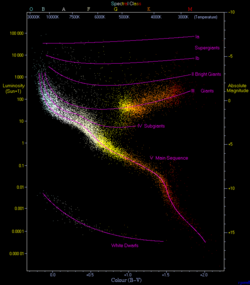
Back Reusester Afrikaans نجم عملاق Arabic Estrella xigante AST Зорка-гігант Byelorussian Гигант (звезда) Bulgarian দৈত্য তারা Bengali/Bangla Divovska zvijezda BS Estrella gegant Catalan ئەستێرەی زەبەلاح CKB Obr (hvězda) Czech


A giant star is a star with much larger radius and luminosity than a main-sequence star of the same surface temperature.[2][3]
Giant stars are up to a few hundred times the diameter of the Sun and between 10 and a few thousand times brighter than the Sun. They do not last as long as most main sequence stars. Stars still more luminous than giants are referred to as supergiants and hypergiants.
A hot, luminous main-sequence star may also be referred to as a giant.[4]
There are a wide range of giant class stars, and sub-divisions are often used to identify particular types. Astronomers use such terms as: sub-giants, bright giants, red giants, yellow giants and blue giants. The giant luminosity class is given the Roman numeral III, for bright giants it is II.
- ↑ Richard Powell with permission.
- ↑ Giant star. In Astronomy Encyclopedia, ed. Patrick Moore, New York: Oxford University Press, 2002. ISBN 0-19-521833-7
- ↑ Giant. In The Facts on File Dictionary of Astronomy, ed. John Daintith and William Gould. 5th ed, New York: Facts On File, 2006. ISBN 0-8160-5998-5
- ↑ Giant star. In Cambridge Dictionary of Astronomy, Mitton, Jacqueline. Cambridge University Press 2001. ISBN 0-521-80045-5